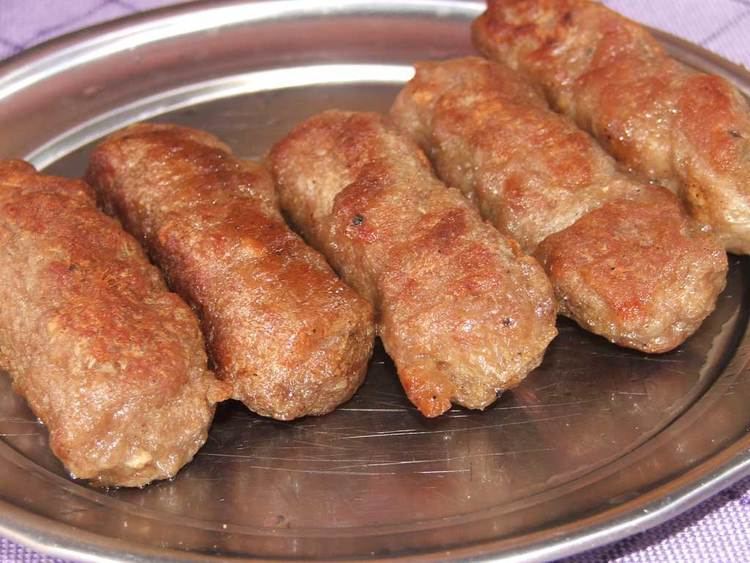 | ||
Similar Pljeskavica, Ajvar, Kaymak, Ražnjići, Börek | ||
Ćevapi ([tɕɛv̞ǎːpi]) or ćevapčići (formal diminutive, [tɕɛv̞ǎptʃitɕi], ћевапчићи) is a grilled dish of minced meat, a type of skinless sausage, found traditionally in the countries of southeastern Europe (the Balkans). They are considered a national dish in Bosnia and Herzegovina and Serbia and are also common in Croatia, Montenegro, Slovenia, as well as in Albania, Republic of Macedonia, Bulgaria, Romania.
Contents
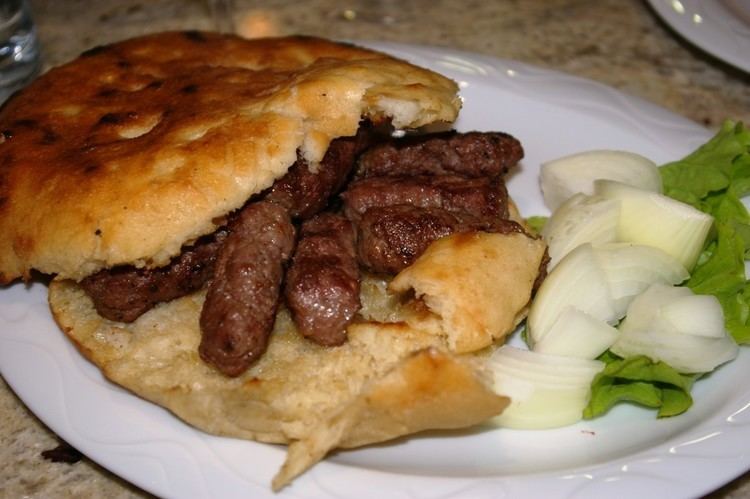
Ćevapi has its origins in the Balkans during the Ottoman period, and represents a regional specialty similar to the Kofte kebab.
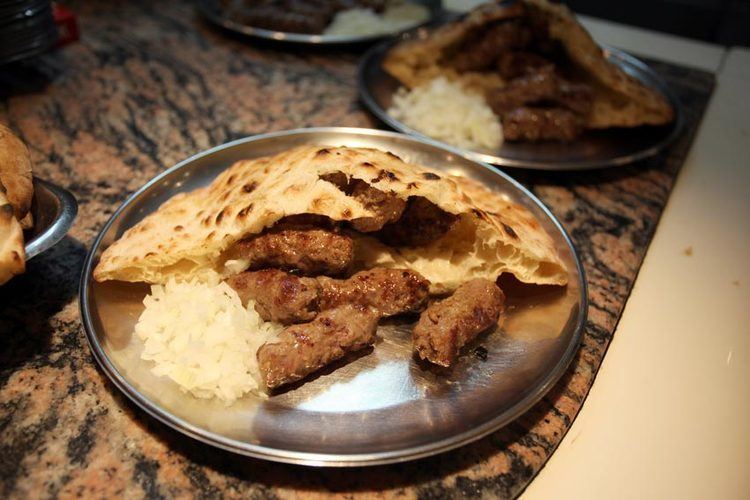
They are usually served of 5–10 pieces on a plate or in a flatbread (lepinje or somun), often with chopped onions, sour cream, kajmak, ajvar, feta cheese, minced red pepper and salt. Bosnian ćevapi are made from two types of minced beef meat, hand mixed and formed with a funnel, while formed ćevapi are grilled. Serbian ćevapi are made of either beef, lamb or pork or mixed. Macedonian, Croatian, Bulgarian and Romanian varieties are often made of both pork and beef.
Name and etymology
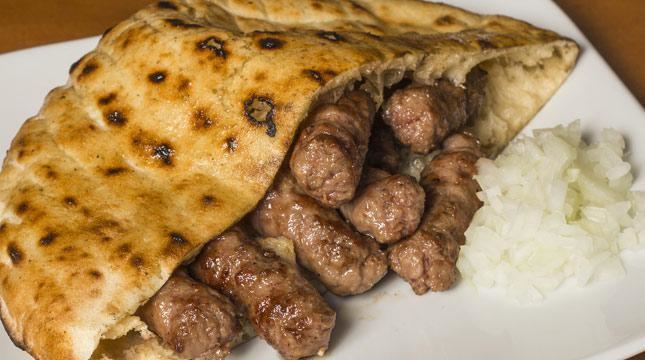
The word ćevap comes from the Persian kebab via Turkish, sometimes with the South Slavic diminutive ending -čići (Bosnian, Croatian: ćevapčići/ćevapi; Slovene: čevapčiči/čevapi; Serbian: ћевапчићи/ћевапи, ćevapčići/ćevapi; Macedonian: Ќебапи, kjebapi; Bulgarian: Кебапчета, kebapcheta, Czech: čevabčiči). The word ćevapi is plural; the singular form ćevap is rarely used, as a typical serving consists of several ćevapi.
History
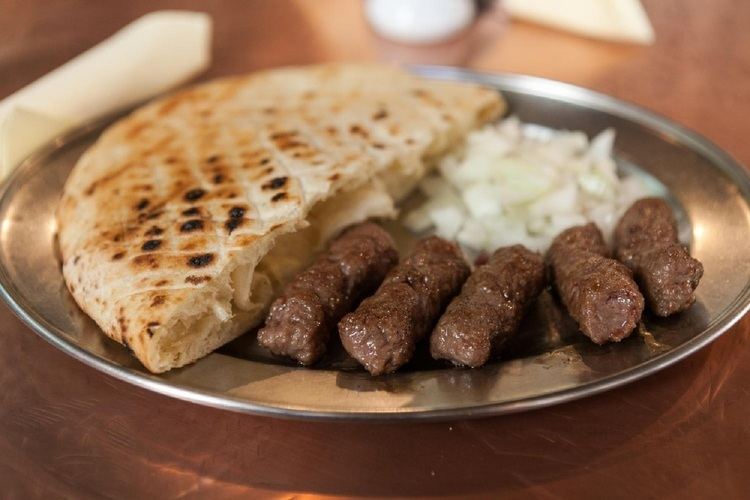
During the Ottoman occupation of the Balkans, hajduks (rebels, outlaws) made the hajdučki ćevap ("hajduk Ćevapi"), which was easy to make, out of pieces of meat and smoked lard on a skewer roasted over fire. The recipe of the Leskovački ćevap ("Leskovac ćevap"), a local specialty of Serbia, was based on traditional Pljeskavica (meat patty), formed as obelisk-shaped meat similar to a sausage (ćevap). Leskovac has a long history of grill shops. In Belgrade, ćevapčići first came from Leskovac in the 1860s, into the kafana "Rajić" at the Great Marketplace (today Studentski Trg), from where they quickly spread across the city, and subsequently, country. The industry quickly multiplied, as ćevapčići was the drinking public's favourite.
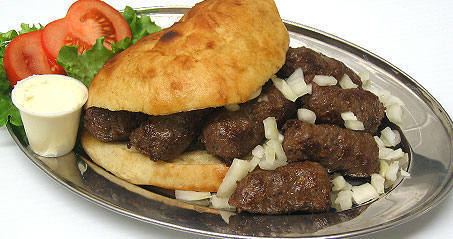
The ćevapčići were served at shops, known as ćevabdžija (pl. ćevabdžije). A 1927–28 study in Belgrade told that people either ate in the restaurant or outside ("on the kaldrma"), often take-away. The shops served from early morning to 10 AM, while often the dish was bought for breakfast.
Before the 1930s, they spread to the rest of the Kingdom of Yugoslavia, including east of Serbia and the Macedonia region. By 1932, ćevapčići were regarded a local specialty in southern Serbia, Skopje and Peć. In 1933, the first street food vendor appeared in Maribor, Slovenia, who came from Leskovac, and served grilled meat, including ćevapčići. In 1940, ten pieces cost one Yugoslav dinar. In the second half of the 20th century, ćevapčići and other Oriental dishes entered Croatian cuisine. The Leskovac-styled grilled meat, including ćevapčići, have today become part of everyday-diet in Slovenia. Today, ćevapčići are found outside former Yugoslavia in the diaspora communities.
Leskovac organizes an annual grill festival, the Leskovac Grill Festival, as a showcase of ćevapi and other grilled meat.
Preparation
They are usually served of 5-10 pieces on a plate or in a flatbread (lepinje or somun), often with chopped onions, sour cream, kajmak, ajvar, cottage cheese, minced red pepper and salt. Bosnian-type ćevapi (halal) are made from two types of minced beef meat, hand mixed and formed with a funnel, while formed ćevapi are grilled. Serbian-type ćevapi (ćevapčići) are made of either beef, lamb or pork, or mixed.
In Austria, Czech Republic and Slovakia, čevapčiči is generally served with mustard mixed with finely chopped raw onions and potatoes or French fries, in a common fast food manner.
In Bosnia and Herzegovina
Varieties include the Travnički ćevapi from the traditionally cattle herder area of Travnik, Sarajevski ćevap from Sarajevo area, that look similar but taste slightly different due to variations in seasoning and meat content (some varieties containing lamb or other non-pork meats), as well as Banjalučki ćevapi which differs not only in taste but also by being grilled and served in connected tuples (usually of four). Tuzlanski ćevapi served in Tuzla area, come in butter rich soup dipped somun - and have distinctive taste as well as texture of bread. In all cases the dish is kept simple, and traditionally served in somun with onions and/or kajmak and yogurt or kefir as appetizer, whereas outside Bosnia, it's common for ćevapi to be served with variety of vegetables and seasonings.
